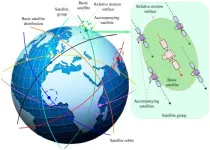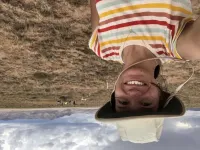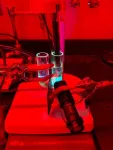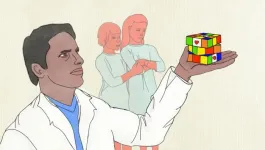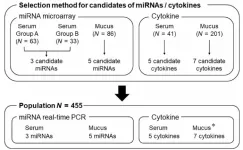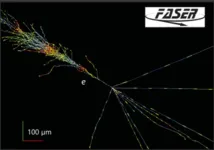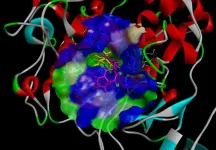(Press-News.org) In an effort to give aspiring journalists hands-on practice in the science news ecosystem and help prepare them for a successful professional career, EurekAlert! is expanding journalist-memberships to applicants working at student news publications, such as campus newspapers and radio stations.
EurekAlert! has historically granted journalist-memberships to full-time journalism students, interns, and fellowship recipients who work at accredited media outlets under the guidance of experienced members. All approved journalist-members receive the same access to embargoed materials.
"As the advisor to MIT's student newspaper, The Tech, one of the first things I proposed to the student science journalists there was to enroll with EurekAlert!,” said Deborah Blum, director of the Knight Science Journalism Program at MIT. “It's one of the best ways I know for them to learn about the wide range of research ideas available to journalists, to explore science studies, and to find smart story ideas.”
“We have witnessed firsthand how the ways people produce and consume news differ and change over time around the world,” said Seth Rose, Editorial Content Manager at EurekAlert! who oversees the journalist-membership application process. “To demonstrate our commitment to diversity, equity, and inclusion in science journalism, we’ve updated our policy to include student reporters from campus outlets among the roles eligible for EurekAlert! journalist membership.”
This expanded eligibility policy aligns with EurekAlert!’s broader, ongoing mission to foster quality science journalism that is more inclusive, accessible, and attainable for all. It also puts into practice some of the knowledge gleaned through various efforts to reach journalists from all regions of the world.
A good example of these efforts is the EurekAlert! Travel Awards program (formerly called the Fellowships for International Science Reporters) for early-career science reporters in low- and middle-income countries (LMICs), which have recognized dozens of science journalists from China, India, Latin America, the Middle East, Africa, the Balkans, and Eastern Europe since 2004. Winners receive travel funding and logistical support from EurekAlert! to attend AAAS Annual Meetings, where they have opportunities to cover the latest scientific research and make connections with scientists, public information officers, and fellow journalists from around the globe.
“Through this program – and the many other interactions with journalist-members – we have come to better understand how news production and consumption habits in many parts of the world don't always mirror the news media norms and structures in North America and Europe,” said Jennifer Holshue, Deputy Director of EurekAlert! who oversees the travel award program.
“This is why we want to provide more opportunities to editorially independent editors and journalists that may fall outside of the global north ‘mainstream,’ and see an expansion of embargoed access to student journalists as a part of that effort."
To help prepare new student-journalist members, EurekAlert! is also launching a new webinar series for journalist-members. The first webinar, “Embargoes 101” will provide an overview of the embargo system, how science news embargoes work, and what journalist-members should be aware of when accessing and using embargoed content obtained from EurekAlert!.
The monthly webinar series is open to all EurekAlert! journalist-members, and is required for all new student-journalists. To sign up, visit: https://airtable.com/appWv6drseoMHYOY1/shryzp9oaMBRZjElk.
Here’s how the application process will work for all student-applicants, including student reporters and journalism students, interns, and fellowship-recipients. Applicants will need to:
Digitally sign an agreement to abide by EurekAlert!’s embargo policy, as all EurekAlert! Members must.
Provide confirmation from a professor, editor, or other faculty supervisors that the registrant is engaged in journalism for their campus publication in the “supporting documents” section of the application.
Attend EurekAlert!’s Embargoes 101 webinar for a short virtual training session on press embargoes and their role in scientific publishing and news reporting.
If you’re a journalist at a student publication interested in joining EurekAlert!, visit www.eurekalert.org/register to get started. Email webmaster@eurekalert.org if you have any questions about the process.
END
Expanding student-journalists' access to EurekAlert!
Platform to launch monthly webinar series to support early-career science journalists
2024-08-05
ELSE PRESS RELEASES FROM THIS DATE:
Planting some tree species may worsen, not improve, NYC air, says new study
2024-08-05
In line with longstanding initiatives to expand its green spaces, New York City is planting tens of thousands of trees each year. They provide shade, lower surface temperatures by releasing moisture, absorb a surprising amount of airborne carbon, scrub out soot and other floating pollutants, and provide wildlife habitat along with just plain beauty. What could go wrong?
Actually, something could go wrong, according to a new study. Oaks and sweetgums, which currently account for a majority of the city’s trees, produce huge amounts of volatile compounds called isoprenes. Harmless by themselves, isoprenes interact rapidly with polluting nitrogen oxides emitted by vehicles, ...
Ben-Gurion University scientist uses state-of-the-art microscopy to discover drug candidates for cancer
2024-08-05
BEER-SHEVA, Israel, August 5, 2024 – Microscopy has been making leaps and bounds in recent years. Science that was inconceivable a few years ago has become a matter of programming state-of-the-art microscopes to process reams of data. Dr. Gabriel Frank quickly realized the potential of cryo-electron microscopy to discover the molecular structures at levels heretofore unobservable. When he joined Ben-Gurion University of the Negev, he pushed for the University to enter the field, culminating in the establishment of the Guzik Center for Advanced Microscopy and the purchase of a new more advanced electron microscope. Using this microscope, Dr. ...
Configuration design method of mega constellation for low earth orbit observation
2024-08-05
First, satellites in the mega constellation are categorized and the constellation design based on different satellite division is proposed. Satellites in the mega constellation are divided into 2 types, namely, the basic satellites and the accompanying satellites. All basic satellites that are surrounded by accompanying satellites are evenly distributed globally, and they have the same subsatellite trajectory. A basic satellite and its accompanying satellites are defined as a satellite group. The constellation is composed ...
Sometimes it hurts to think
2024-08-05
If somebody complains that it hurts to think, they may be onto something, as mental exertion appears to be associated with unpleasant feelings in many situations, according to research published by the American Psychological Association.
“Managers often encourage employees, and teachers often encourage students, to exert mental effort. On the surface, this seems to work well: Employees and students do often opt for mentally challenging activities,” said senior author Erik Bijleveld, PhD, of Radboud University. “From this, you may be tempted to conclude that ...
FAU lands $1.3M NSF grant to boost dryland soil quality amid climate stressors
2024-08-05
Drylands, found across every continent, cover about 45% of the Earth's land surface and support 38% of the human population. In these regions, precipitation is low and evaporation rates are typically high, leading to an arid or semi-arid climate. Due to scarce water resources and sparse vegetation, drylands present formidable challenges for agriculture and human habitation. As the climate continues to warm, drylands are rapidly expanding.
A particularly urgent problem in drylands is climate-driven soil degradation, which affects about 33% of the planet’s land surface.
Drylands host ...
Self-powered pump harnesses light and chemistry to target, capture pollutants
2024-08-05
Dartmouth researchers have developed a self-powered pump that uses natural light and chemistry to target and remove specific water pollutants, according to a new report in the journal Science.
As water enters the pump, a wavelength of light activates a synthetic molecular receptor designed to bond to negatively charged ions, or anions, a class of pollutants linked to metabolic disruptions in plants and animals. A second wavelength deactivates the receptors as water exits the pump and causes them to release the ...
Heart transplant list doesn’t rank kids by medical need, Stanford Medicine-led study finds
2024-08-05
The method used across the United States to wait-list children for heart transplants does not consistently rank the sickest patients first, according to a new study led by Stanford Medicine experts.
The study will publish online Aug. 5 in the Journal of the American College of Cardiology.
Adding nuance to the wait-list system by accounting for more health factors could reduce children’s risk of dying while they await donor hearts, according to the study’s authors. A revision to the way donor hearts are assigned is already in process. The study adds evidence for why it is needed, they ...
Advancing towards a novel, highly accurate method for cervical cancer screening
2024-08-05
Cervical cancer is a highly prevalent cancer, with approximately 500,000 new cases diagnosed each year. Shockingly, the number of individuals diagnosed with precursor lesions in the cervix—also known as cervical intraepithelial neoplasia (CIN)—is 20 times higher. As with many potentially malignant conditions, early diagnosis of cervical cancer can make all the difference in a patient’s life in terms of treatment outcomes. For this, developing effective, convenient, and easily available screening protocols for CIN and cervical cancer is of paramount importance.
Currently, the two ...
First measurement of electron- and muon-neutrino interaction rates at the highest energy ever detected from an artificial source
2024-08-05
Neutrinos are fundamental particles in the Standard Model of particle physics, notable for their extremely small masses and weak interactions with matter. They are important for answering fundamental questions about the universe, including why particles have mass and why there is more matter than antimatter. Despite being abundant, their weak interactions make their detection difficult, and hence they are called “ghost particles.” At any given moment, numerous neutrinos freely pass through the Earth and our bodies, which originate from the Sun or cosmic rays. Understanding their rare interactions with matter is crucial for obtaining a more complete picture ...
Breakthrough: Natural bacteria compound offers safe skin lightening
2024-08-05
Melanin protects the skin—the body's largest organ and a vital component of the immune system—from the damaging effects of ultraviolet (UV) radiation. When the skin is exposed to UV radiation, melanin production is stimulated in melanocytes, with tyrosinase playing a key role in the biosynthetic pathway. However, disruptions in this pathway caused by UV exposure or aging can lead to excess melanin accumulation, resulting in hyperpigmentation. To address this, tyrosinase inhibitors that suppress melanin synthesis have become valuable in the cosmetic industry. Unfortunately, some of these compounds, ...
LAST 30 PRESS RELEASES:
iPS cells from dish to freezer and back
Deep neural networks enable accurate pricing of American options under stochastic volatility
Collective risk resonance in Chinese stock sectors uncovered through higher-order network analysis
Does CPU impact systemic risk contributions of Chinese sectors? Evidence from mixed frequency methods with asymmetric tail long memory
General intelligence framework to predict virus adaptation based on a genome language model
Antibiotic resistance is ancient, ecological, and deeply connected to human activity, new review shows
Vapes, pouches, heated tobacco, shisha, cigarettes: nicotine in all forms is toxic to the heart and blood vessels
From powder to planet: University of Modena engineers forge a low-carbon future for advanced metal manufacturing
Super strain-resistant superconductors
Pre-school health programme does not improve children’s diet or physical activity, prompting call for policy changes, study finds
Autumn clock change linked to reduction in certain health conditions
AI images of doctors can exaggerate and reinforce existing stereotypes
Where medicine meets melody – how lullabies help babies and parents in intensive care
We may never be able to tell if AI becomes conscious, argues philosopher
AI video translation shows promise but humans still hold the edge
Deep ocean earthquakes drive Southern Ocean’s massive phytoplankton blooms, study finds
Without campus leftovers to pick through, the beaks of this bird changed shape during the pandemic
High-dose antibiotic does not reduce mortality in tuberculous meningitis
How many insects fly in the sky above the USA?
Could cheese protect your brain health?
Who faces more difficulty recovering from stroke?
Colliding galaxies create the brightest, fastest growing black holes at their center
New BrainHealth research reveals tradeoffs on sleep with cannabis use for chronic pain
Aging-US now on ResearchGate, enhancing visibility for authors and readers
'Molecular glue' stabilizes protein that inhibits development of non-small cell lung cancer
Mount Sinai Health System is recognized in 2025 Chime Digital Health Most Wired survey
From prey to predator: How carnivores spread beneficial fungi
Menopause symptoms may be frequent and have negative effects, according to female endurance athletes
US Congressmembers’ responses on X to mass shooting events differ along party lines
KAIST-UEL team develops “origami” airless wheel to explore lunar caves
[Press-News.org] Expanding student-journalists' access to EurekAlert!Platform to launch monthly webinar series to support early-career science journalists

